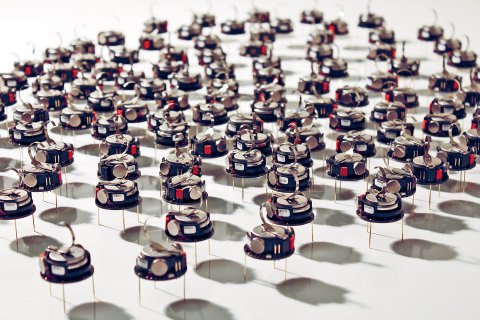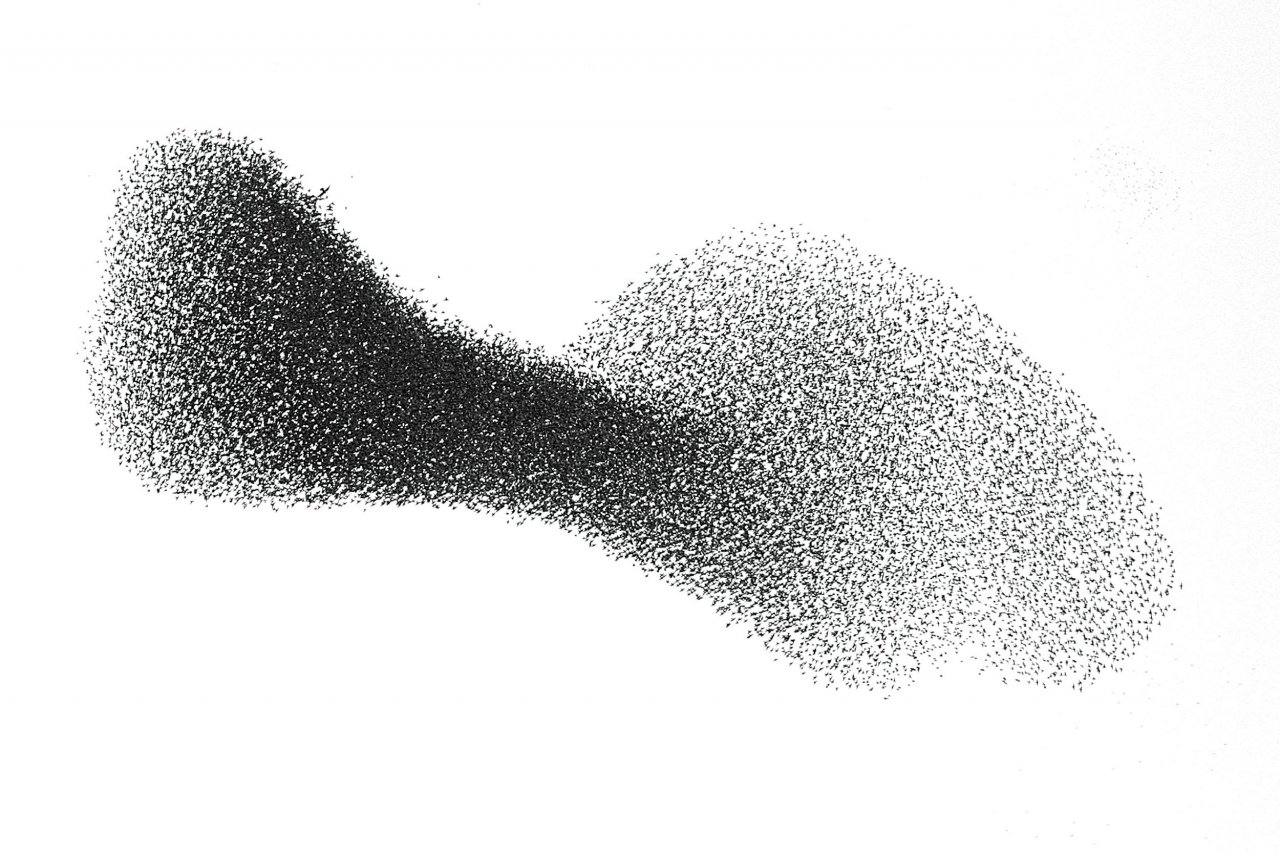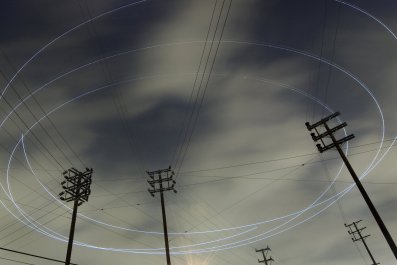When the first human colonists land on Mars several decades from now, their habitat will already be waiting. They may not even have to don a space suit, instead simply walking down the gangplank in their civvies into a warm, well-lit Martian home.
That's because if we ever do colonize Mars, chances are that our first emissaries will be hardy robots, sent to the Red Planet with construction materials and an organizing principle called "swarming," borrowed from insects like termites and ants. With nothing but a few rules and a blueprint in their tiny robot brains, hundreds of relatively primitive machines will have built a complex, airtight structure suitable for human habitation in a fiercely lethal environment.
This robot phalanx will have completed their handiwork more or less without supervision, while other teams of bots back on Earth will have similarly built mining operations deep beneath the ocean, assembled solar farms in heat-seared deserts and topped off the world's first mile-high skyscraper—all without risk to a single human life.
Big, smart, complex robots may get all the headlines (Kuka's Ping Pong champ is just the latest), but the robots that will help humans the most in the future may be small, simple and as dumb as a desk lamp—on their own. But collectively, swarms of these tiny robots could reach the heights of sophistication.
Don't worry. Swarm bots won't make human workers redundant; instead, they'll extend civilization into dangerous or otherwise uninhabitable environments and create new ways to solve tough problems. In fact, our culture's great fear of robotic automation obscures the vast and varied new job base it will create for designing, building and deploying robots. Like computers, they'll eliminate some jobs, but they'll also generate whole new categories of employable skills for humans.
The field is just beginning to explode. The first swarm laboratories were built in the 1990s, and until recently, most funding came from grants, meaning the research was relatively slow-moving. But that's starting to change as entrepreneurs emerge and big companies and the defense industry wake up to the field's potential to solve problems in ways that are less costly, more energy-efficient and less invasive than the previous go-to solutions: big machines. Some of the world's biggest and most aggressive companies—including Google (eight robotics companies purchased), Apple, Amazon, Samsung and Boeing—have all begun to invest in their own swarm research. Labs doing swarm work with corporate or government backing can now be found in many major U.S. and European universities. And one experiment—ants swarming in zero gravity—just concluded on the International Space Station.
After years, the technologies needed—computer chips, motors, actuators, materials, sensors—are finally here and keep getting better in speed, sophistication and (important for small robots) miniaturization. Already, a fleet of quadrotors (small helicopters with four rotors) has painted the night sky at festivals, with synchronized spectacles that rival any fireworks display—and without gunpowder. The first truly sophisticated robot flying machines, engineered by two former robotics specialists at the University of Pennsylvania, can loop-the-loop in a split second ("coming soon" from KMEL and Yuneec, base price: $3,000).
But the big challenge in swarm technology is not figuring out how to get one robot to move. It's getting a solid understanding of how robot groups can move as their individuals encounter other objects and each other, amid the "noise" of wind or a complicated visual field like, say, the corner of Randolph Street and Michigan Avenue in Chicago. In brief, what swarm roboticists struggle with is the math to let simple robots discern real information and ignore distractions.

Math in Miniature
You've probably seen a school of fish or a flock of birds—starlings and blackbirds display dramatic examples of this type of animal behavior. A swarm is a group that acts as if there is an overall, unifying intelligence. A swarm is almost an organism and can accomplish much more than any individual member. The Lilliputians who tied down Gulliver? They were a swarm.
Insects like ants and termites are the swarms du jour for scientific study and inspiration. That's because they are "scalable" (they succeed whether there are 10 or 10,000), "parallel" (they behave the same way at the same time) and "fault-tolerant" (a term that means a few losses are not material; if your boss says the company is now fault-tolerant, update your résumé pronto).
A swarm is an accumulation of local actions. One member of the swarm reacts based on its contact with immediate neighbors, whoever they are. A murmuration of starlings, for example, will evade an approaching hawk starting with the first bird that detects it, which communicates its fear to its neighbors, who do the same until the whole crowd flees in ripples and swirls.
Swarms often work by "stigmergy," a term coined by French biologist Pierre-Paul Grassé in 1959 to describe termite behavior. He defined it as "the stimulation of workers by the performance they have achieved." It has come to mean a mark left in the environment. Think of stigmergic marks as road signs: A termite makes a ball of mud laced with pheromones (chemicals that affect behavior through smell) and puts it down. The next mud-ball-making termite that happens along smells the first, makes its own ball and adds it to the pile. Millions of balls later, a hollow mud spire stands 8 feet tall, as outlandish as the towers of Turkey's Cappadocia region—a magnificent termite-apartment complex.
Each individual in a swarm acts seemingly at random—scientists term this "stochastic"—yet as a group a swarm is amazingly focused, coherent and logical.
Translating nature to math can be staggeringly difficult. As James McLurkin, head of the Multi-Robot Systems Lab at Rice University, points out rather drily, developing the right algorithms is "nontrivial." (An algorithm is a mathematical formula that provides instructions.) "The bulk of our research is algorithms," affirms Raffaello D'Andrea of the Swiss Federal Institute of Technology Zurich. On the one hand is the reality that robot reaction is so much faster and better than even human athletes—small quadrotors, for example, adjust their rotors a stunning 600 times a second. On the other, a solid scientific grasp of intelligent human decision making is beyond the visible horizon. Complex motion is difficult enough to turn into numerical instructions.
McLurkin offers an example of the complexity (slightly adapted here): On a frozen lake, eight blindfolded, earplugged people with ice shoes try to move a stalled fisherman's car. They all sense each other pushing, and by the miracle of swarm intelligence they eventually do push in one direction. But how do you specify the right direction?
The thinking is that the math needed to enable a fully mobile swarm of robots will be fundamentally different from typical computer algorithms. Instead, it's going to come from the real world. The question we need to ask, according to Harvard research scientist Justin Werfel is: "What programs are the termites running?"

Termites and Bricks
Social scientists who have observed these types of group dynamics have already found some practical applications: improving the flow of passengers onto airplanes and landed planes to gates, fabricating credible mob scenes in movies and reducing lines in theme parks. On Broadway, Disney recently employed a notion of swarm intelligence called "optimization" (also known as dynamic pricing) to make its 16-year-old show The Lion King the surprising top earner on Broadway in 2013.
These applications are only the beginning. Observing Australian and African termites constructing tall, massive nests as a grad student, Werfel wondered if he could engineer robots to behave similarly. A decade later, he and his Harvard colleagues proved that termite-like robots—free agents, aware only of their surroundings, committed to a few simple actions—can build complex structures on their own, including a miniature skyscraper, using a method called autonomous construction.
The math Werfel had to cook up for his robots challenged him for much of a decade. While he worked the numbers, Kirstin Petersen, a colleague at Harvard's Wyss Institute for Biologically Inspired Engineering, concentrated on the robot design. Unlike most researchers, they built their robot from scratch, ultimately making many of the little bots using a 3-D printer.
The idea was that a group of these simple 8-by-4.5-inch machines would complete a predetermined design that resided in their brains. The scientists basically wound them up and watched them go. To understand their local world, each robot used seven infrared sensors, five ultrasound sonars and a device (called an accelerometer) that told its brain whether it was climbing up or down. The bots located a square foam brick, picked it up, selected a place on the structure for it, aligned the brick and deposited it—a process the swarm methodically repeated until the structure was finished.
Bricks weren't placed in any sequence; the robots simply followed basic do's and don'ts and not a specific path. Instructions about how to move were minimal, barely taxing the onboard chip. Yet they allowed multiple robots to work at once, prevented collisions, avoided robot gridlock (a surprisingly common and hard-to-overcome problem) and let the robots build a complex, multistory structure much as termites and ants do.
The project also showed that, on a much larger scale, swarms might be used to build a city. Urban areas tend to grow haphazardly without a preplanned goal, and this also turns out to be an ideal task for an autonomous team of mobile machines.
There are good reasons construction is a major thrust of swarm research. The "workers" don't need sick days, sleep or oxygen—just recharging. They don't make mistakes: The code makes a robot always check that it's doing the right thing. And they stay focused. Say a squall howls through a work structure— the swarm just keeps moving, while human workers might over- or underreact, or think first about their own safety (as well they should).
In a striking demonstration by researchers from the Swiss Federal Institute of Technology Zurich at the FRAC Centre, a museum outside Paris, Raffaello D'Andrea's team showed that a flying robot swarm could erect a sensuously curvaceous tower of open blocks nearly 20 feet high, working continuously over four days. The quadrotors set down the fudge-bar-size blocks in sequence. Every few minutes, a robot would leave the queue and head to a dock for charging. When the six-meter tower was complete, the robots came to rest.
Equally impressive, at the University of Pennsylvania, the GRASP lab led by Vijay Kumar programmed a swarm of quadrotors, designed and built by engineers Alex Kushleyev and Daniel Mellinger, to erect a small-scale beam-and-column structure with impressive precision. The 8-inch flying bots sensed if a component wasn't properly aligned and retried until it was. It's easy to imagine full-scale machines doing the same thing with steel I-beams, though lots of engineering needs to happen first. (Construction unions need not panic yet.) And the lab's process depends on wall-mounted cameras, meaning the robots were not truly autonomous. However, another flying robot from GRASP can enter a small unknown interior uninformed; build a 3-D map of the space fully autonomously, using only a Microsoft Kinect system for orientation and a laser scanner; and send the map to its managers. Combine these two technologies and you have a swarm of bots that can build things and find their way around on their own.
Swarm technology need not be confined to flying or crawling. MIT researchers in the Distributed Robotics Laboratory overseen by Daniela Rus are working with tiny identical robots that use themselves as building material: They join to become useful shapes. A critical early step is the M-block, a small cube that is mobile, despite the lack of exterior moving parts. Inside is a tiny flywheel spinning at up to 20,000 revolutions per minute. When the wheel is braked, the cube lurches into motion. It can roll and even leap into the air, thanks to the law of angular momentum. Magnets on each of 12 edges and six faces attract and attach cubes to each other. The cubes can move individually in any direction, or together in units, and the cubes can magnetically "push" other cubes—the possibilities are endless.
The next step is to build hundreds of cubes and then, researcher John Romanishin says, have them "identify each other, coalesce and autonomously transform into a chair, or a ladder, or a desk on demand." Or, like army ants, build spans from one side to another, using swarm intelligence to assemble themselves into an architectural structure.
Another approach from the same MIT lab, dubbed "smart sand," theoretically uses swarm technology to make 3-D copies. Its design uses a large collection of robot pebbles fitted with "electropermanent" magnets. Once smart sand covers an object, the granules collectively convey the exact dimensions of the shape they've contoured to a nearby reservoir of smart sand, which self-assembles into that same shape. Eventually, the smart sand itself could be instructed to coalesce into a strong 3-D design, sort of like the intelligent metal in Terminator 2—a real boon for a field worker or astronaut in need of a critical tool.
So far it's all in miniature, but that's where science and engineering start. Think of a model ship in a test tank, a tiny rocket in a wind tunnel. The ramp-up from a model-scale proof of concept to full-size machine can be rapid. First, swarm robotics in the real world could take over current tasks among the Three Ds—dull, dirty or dangerous: work humans won't or shouldn't do.
Then they'll learn to do jobs humans can't do. The physical world is shifting rapidly; global climate change is affecting temperatures, weather patterns and landscapes across the planet. And robots will help humans adjust to the changes: Having swarms of helpers to build sandbag dikes, repair infrastructure and locate survivors is likely to be more than just welcome—it might be absolutely essential, a guiding technology for the next phase of civilization.


























